It was 4am and a pair of headlights beamed down my Brooklyn block. Freestone Expedition’s co-founders, Owen and Greg, sprang from either side of a parked SUV like it was a jack-in-the-box. After we exchanged greetings – theirs caffeinated and warm; mine mumbled and subdued – they directed me to scrunch my backpack (so empty it flopped) between the mountains of gear in their trunk.
Owen, the lead fisherman, is a wiry and energetic former Wall Street trader; a lifelong angler who curses when there’s a “fish on” and curses when the fish won’t bite. Greg is the duo’s bushcraft virtuoso; a placid jokester with deadpan delivery so dry you have a peer through the thicket of his beard for evidence of twinkling eyes. A twinkle means he’s messing with you. No twinkle means he’s communicating dead serious guidance on outdoor safety.
Buckled up, we drove an empty road to pick up the third member of our crew: OutdoorFest Founder, Sarah Knapp. Waiting in darkness for her car to pull into our designated rendezvous spot – a Holiday Inn in New Jersey – Greg spotted a rabbit lurking in the landscaping. “Dinner?” he asked. “The trout is catch and release. But bunnies are fair game.”
In the car, Owen told us the history of East Coast trout. Only Brook Trout are native. You can find German Brown Trout and Rainbow Trout in Big Water, though these were introduced by man. In spite of the common association between fly fishing and the West, fly fishing was introduced to America – and flourished for a golden era stretching from the late 1800s to the early 1900s – in the Catskills.
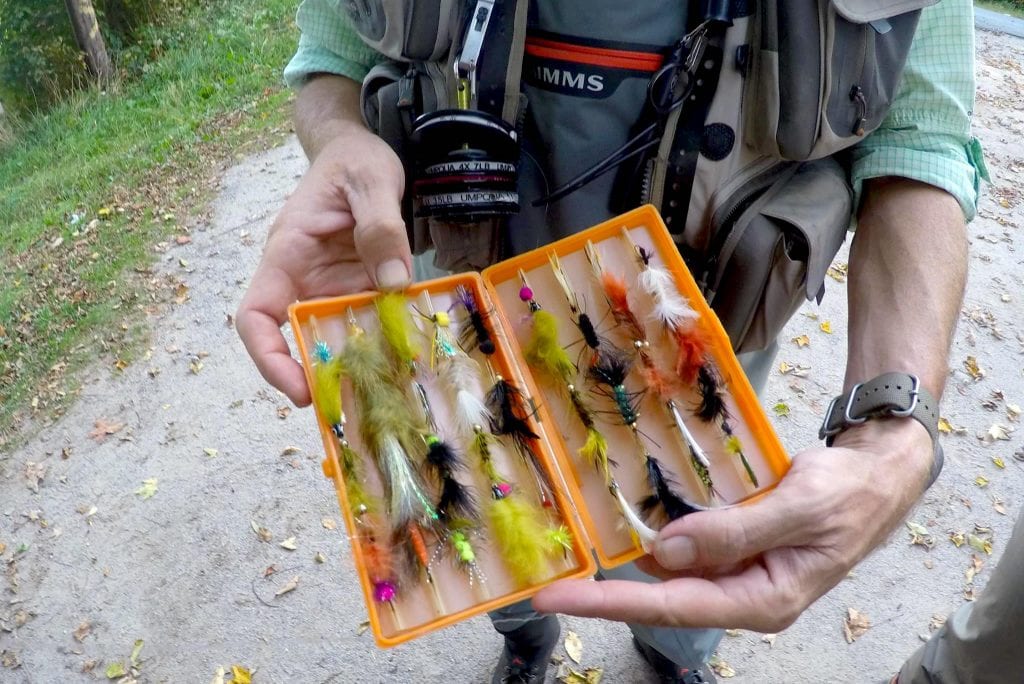
After driving for 3 hours, we pulled into a gravel parking lot maintained by the State Parks Department. As we began to unload gear, (Freestone’s shtick is to provide 100% of the requisite fishing and camping gear) I casually dropped that I accept tents as a necessary protection against adverse weather, but have always found them a little stifling. Owen and Greg didn’t miss a beat,“Up for a 2-mile hike?” Greg asked. “There’s a fantastic lean-to just up the trail. We’re here early enough to snag it.”
By 8am, around the time my daily alarm goes off, I was already in the Catskills, setting up camp at a spot with a lean-to and fire pit. Owen was antsy to fish, so Greg offered to hold down the fort and await the arrival of our final crew member, Townsend, a friend of his and our executive chef for the weekend. When we asked Greg if he’ll be alright alone, he tugged on his beard and says, “no one will mess with a man who looks like a Duck Dynasty cast member.” He’s probably right.
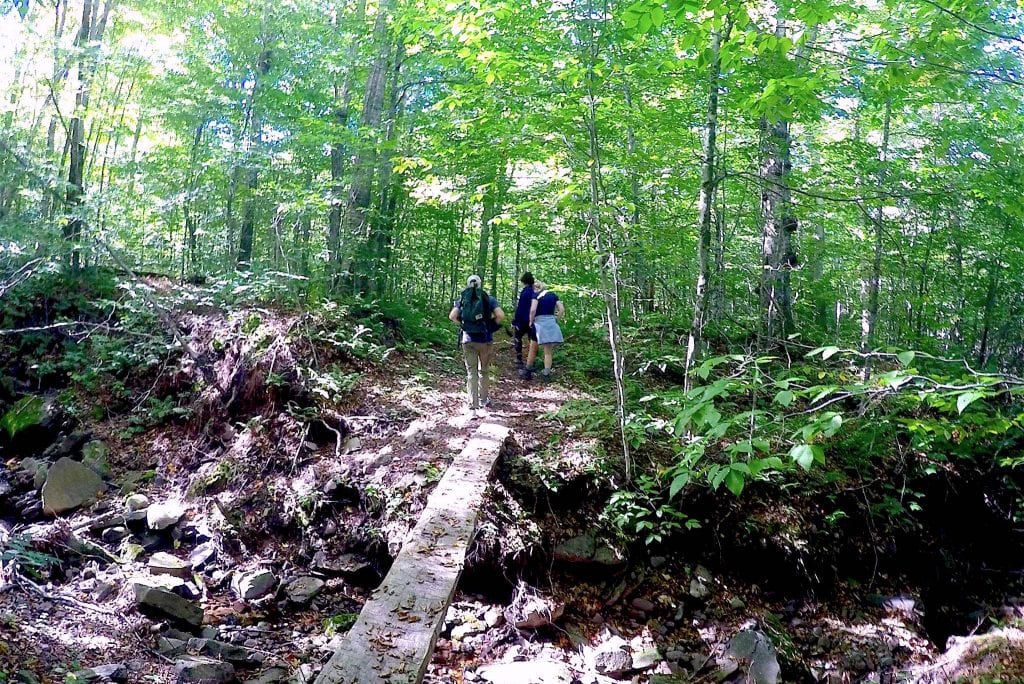
Finally, Fly Fishing in the Catskills
We hiked the 2 miles back to the car, this time unburdened of gear and in half the time, to fish a promising roadside creek. There was no need for waders in this water, which, due to drought, barely passed my ankles in spots. I changed into Chacos and practiced my roll cast (the low tree cover precludes backcasting), trying to think like a fish. Owen stood behind me, out of the peripheral vision of the fish, whispering tips on strategy. “Brook trout spook easily, they’re not aggressive like the big guys,” Owen explained.
“Pretend you’re a fish, okay? What do you want? You want to eat. You want to conserve energy. You want to avoid being eaten. That’s it.”
I dropped my fly near a crop of rocks. I let it drift naturally, stripping line in gently to keep it taut. Owen cautioned me to avoid tugging too severely, which can make the fish suspicious. “It’s September,” he said. “These fish are smarter than they were in May. They’ve been caught too many times to fall for anything that looks off.”
I landed a good cast. The line tugged, I shouted “FISH ON”, and set the hook by sharply bringing my rod straight up. Owen tumbled out of his coaching slash hiding place in the woods, whooping loudly, to walk me through reeling it in. The truth is, it was easy. I’ve heard my father – a fly fisherman for decades – tell stories of losing a beautiful fish at this stage, but he’s talking about rainbows, big suckers powerful enough to give you the slip. The brook trout feels strong in the water, but not stronger than the fisherman.
When I reeled in the brookie, it was small enough to fit in my palm, with bright polka dots the color of Starbust wrappers. It alternated between flopping for freedom and resting dead still against my fingers. Owen showed me how to unhook it, gently holding it with one hand and removing the hook just as gently with the other. It lay motionless when Owen took the hook from its lip, and I thought about the long season of fishing in this water. The fish looked to me like it knew the drill.
I caught two more fish that morning. Each time, I was elated at the call and response of a satisfying cast and a fish’s bite. But each time, I bungled the unhooking, my nerves and empathy overwhelmed by the tiny thrashing muscle with eyes. Owen appeared each time, to expertly release trout from hook, calming the fish and me with sure and steady movement.
After a quick lunch of cheddar cheese and turkey slices, we hiked back up to the lean-to and settled in for a quick nap. In the afternoon sunshine, I awoke and found my way to the water’s edge just down the hill from camp with Owen for more fishing in the golden September afternoon.
It was the smell of the campfire drew us back to the camp before dark. So complete was Greg, Owen and Townsend’s commitment to a full service trip, that when Sarah and I offered to help with dinner for the fifth time, Greg sent us on a mission to find a large, broad-sided log. When we dragged it back, he handed us a package of throwing stars and said, “Here, stand back and try to get these to stick in the log.” Here, kids. Go play with these weapons while the adults make dinner. We understood then that help would not be allowed, and played with weapons ineptly until summoned for cocktails.
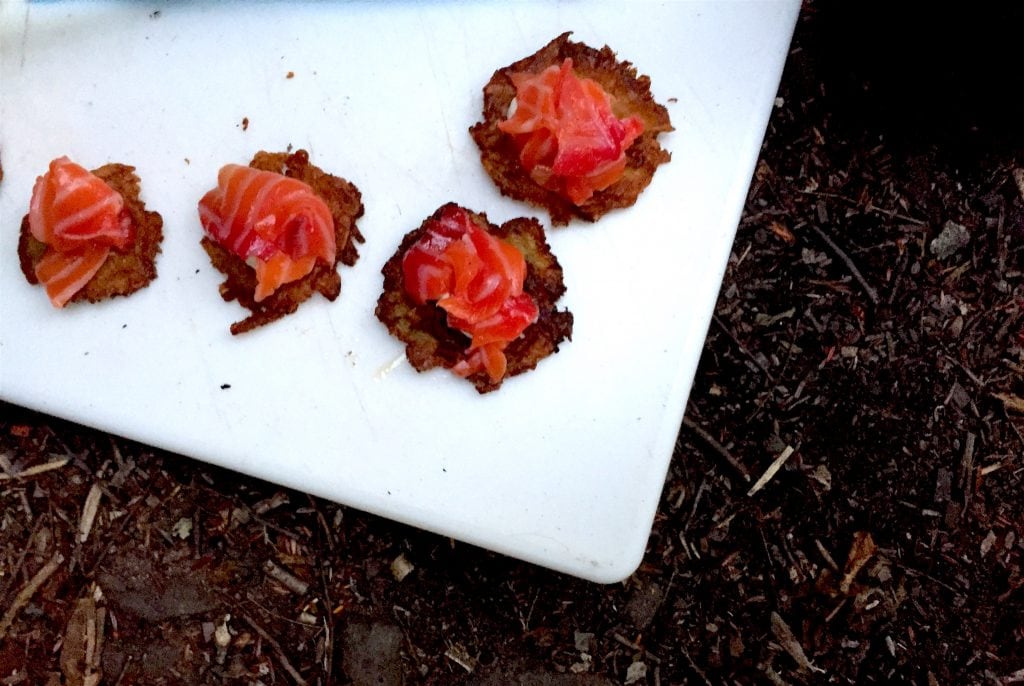
Townsend worships Francis Mallman, the Argentine chef who authored “Seven Fires.” In Mallman’s signature style, he buried a cabbage, a fennel bulb and an eggplant under the coals of our campfire. A skirt steak sat on top of the embers. We snacked on potato latkes with crème fraiche and salmon that Townsend cured in beet juice. When the steak was done, and removed from the coals to cool on the log that served as our cutting board, Townsend prepared a salad course of corn and tomatoes. Then, we tucked into the coal-roasted veggies and expertly sliced steak, all of it dusted in dill. It’s decadent camp food. Camp food only on a technicality, really, though the charred flavor connects it to the stuff I know. For dessert, Townsend introduced me to a mind-bending twist on s’mores, substituting a Reese’s Peanut Butter Cup for the classic Hershey Bar.
Around the campfire, Greg told us stories about bears. He also told us how he learned bushcraft. After working the night shift at a gas station, teenage Greg would enter a nearby state park barefoot without a headlamp to smell, feel and hear his way through the forest. It was Greg’s birthday, so when he headed off to string a bear bag 20 feet in the air, we strung a birthday banner from each end of the lean-to. We sang Happy Birthday and crawled into our sleeping bags.
On Sunday morning, we slept in. We took our time with breakfast. An egg scramble was a nourishing and convenient solution for leftovers. We would cart them out in our stomachs instead of in trash bags. When the campsite was pristine – Greg is a militant practitioner of Leave No Trace – we hiked the 2 miles back to the car to drive in search of “Big Water”. On the trail, we passed a man with a rod strapped to the back of one shoulder and a rifle strapped to the other. He was hopeful that the lean-to was free, and we assured him that the most picturesque campsite in the Catskills was all his.
A sandy, wide banked river ran alongside the road back to the city. We parked beside it. The water was clear; so clear that we could see a fat old German Brown loafing. Owen motioned for us to sidle and crouch, avoiding the trout’s field of view. “If we can see him, he can see us,” he warned.
Just then, a station wagon pulled up and unspooled into a gaggle of children and a chocolate lab. Their bodies bounded into the water and, when their thousand ripples subsided, the fish was gone. Owen shook his head, cursed, and sent us back to the car, in search of a river less appealing to bathers on a hot day.
We found one. The current was strong, the eddies where fish might conceal themselves were many and turgid, and the weeds along the uneven banks were waist-high.
Into the waders I crawled, wearing a pair of boots that belong to Owen’s wife, whose feet just happen to be a size 8. Greg snaps a picture. On his iPhone screen, I look comfortable slipping the straps over my shoulders, like I’ve done this before. Owen and I plod through the brush with our rods, looking for an entry point; somewhere that might mean fish.
Once Owen identified a promising spot, we waded into the river. However amateurish I felt slipping on slick rocks Saturday, it did not prepare me for the pressure of the current against my thighs as I walked upstream. The riverbed undulated beneath my boots with each step. The overall effect on my legs was simultaneously like walking on the moon and walking in a super-gravitational field. Everything felt woosh in all directions.
This is the part of the story where I’d like to report that I caught a big fish, a cousin of the lazy brown trout. Instead, Owen coached me on my casting and my float. When I had the float down, he delivered a tight and lively lecture on how to select a fly. I learned the difference between a wet fly and a dry fly, and when to use what. He reached into his tackle box to show me a nymph. We discussed the life cycle of the fly.
Even though this is not the part of the story where I report that I caught a big fish, nor a small fish, it is my favorite part of the story. The 4:00pm sun was low and cast long shadows on the river. The current’s pull on my body was meditative. Owen’s voice was too. It was surreal to be inside a river. Water surrounded me – pushing and pulling me – but I was mainly warm and curiously dry.
Discouraged and conscious of the fading afternoon, Owen called it: “the fish aren’t biting. It’s time to drive back to the city.” We drove the 90 miles back in tired silence – past farmhouses, shuttered summer camps, and suburban homes hosting Sunday dinners until we stopped on my block, where it was dark again.
Fishing Gear You Need
Before heading out on the water, it’s important that you know what you need for your fishing trip. Do you need a rod and reel? Do you need a knife? Maybe some fishing waders? If you don’t have all the equipment you need, you might end up wasting time on the water and not catching any fish.
To help you out, here is some fishing gear you need:
- Reel
There are two types of reels that you can choose from: electronic and magnetic. A magnetic type is more durable and is easier to fix a line on when things happen to go wrong. Moreover, when fishing during spring–when the ice starts to melt–it’ll be much more difficult to fish without a reel.
When you’re choosing a reel, one of the best choices is a multi-rope. They’re very effective when fishing for trout in the spring because of their versatility and speed. But if you’re planning on fishing for larger fish, they’re not advisable. This is because when larger fishes are coming up to feed, they have the strength to knock over and damage your multi-rope.
- Hook And Line
Another great item on the list of fishing gear you need is a hook and line. If you plan to catch small fishes, you probably only need a small hook since most fishing reels can handle very small fishes. However, if you’re planning on fishing for trout in the spring and summertime, and you want to make sure that you’re catching the big ones, then a longer hook is going to be needed.
- Spinner Bait
A last great option on the list of fishing gear you need is a spinnerbait. These baits are very effective in luring fish into the water, and they’re also very easy to use. However, they’re heavy and not appropriate for fishing for trout in the spring or for fishing in larger bodies of water.
Using a fishing reel and spinnerbait is a great choice for a beginner. It can easily get them started and they’ll feel confident and comfortable with the sport when they start their fishing trips in the spring or summer.
Buying Your Fishing Equipment
There are a lot of different shops to choose from and they all have varying prices. If you shop around a little, you’ll be able to find the best deal.
Alex Kalita is the co-founder of Common Bond Design, an interior design firm in Brooklyn. A lifelong hiker turned recent dabbler in adventure travel (and writing about it!), she sees strong parallels between design for the outdoors and design for the indoors. Alex enjoys applying lessons drawn from nature to the more permanent shelters her clients occupy.



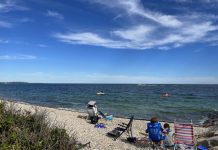
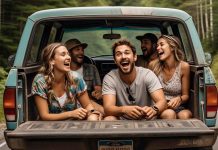





 Sarah Knapp is a Brooklyn based entrepreneur whose love for the outdoors and community building led her to the October 2013 creation of OutdoorFest. She has a BA in History, is a Wilderness First Responder and a NY state hiking, camp and boating guide. Her proudest achievement to date is reading the Aeneid in Latin.
Sarah Knapp is a Brooklyn based entrepreneur whose love for the outdoors and community building led her to the October 2013 creation of OutdoorFest. She has a BA in History, is a Wilderness First Responder and a NY state hiking, camp and boating guide. Her proudest achievement to date is reading the Aeneid in Latin. 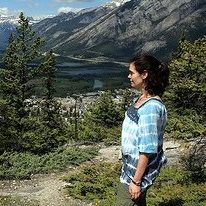 Allison was one of our first top writers and Chief Editor but is no longer working with offMetro. Allison is a native New Yorker, who has lived in Rome, Tuscany, Melbourne, Toronto and Los Angeles. She frequently contributed travel pieces to Family Travel Forum, using her own children as guinea pigs as they travel the globe. She never missed a chance to sample local delicacies, as her love for travel goes hand-in-hand with her love for food and wine.
Allison was one of our first top writers and Chief Editor but is no longer working with offMetro. Allison is a native New Yorker, who has lived in Rome, Tuscany, Melbourne, Toronto and Los Angeles. She frequently contributed travel pieces to Family Travel Forum, using her own children as guinea pigs as they travel the globe. She never missed a chance to sample local delicacies, as her love for travel goes hand-in-hand with her love for food and wine. 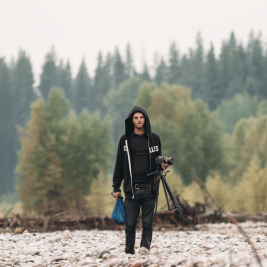 Josh Laskin is a freelance travel writer and photographer based in the White Mountains of New Hampshire. When he is not at work or on the road, you can find him in the mountains snowboarding, climbing, hiking, fly fishing, mountain biking, and eating bagel bites.
Josh Laskin is a freelance travel writer and photographer based in the White Mountains of New Hampshire. When he is not at work or on the road, you can find him in the mountains snowboarding, climbing, hiking, fly fishing, mountain biking, and eating bagel bites.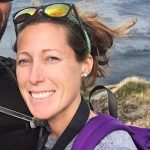 Annie is a travel writer, environmentalist, and surfer based in Venice, CA. She heads up our West Coast team, keeps our grammatical errors in check, and makes sure our California writers always have a plan for their next adventure. Follow Annie’s travels @annelisemcb.
Annie is a travel writer, environmentalist, and surfer based in Venice, CA. She heads up our West Coast team, keeps our grammatical errors in check, and makes sure our California writers always have a plan for their next adventure. Follow Annie’s travels @annelisemcb. Carly Pifer is a freelance writer who has been known to follow whims inspired by romantic movie scenes or colorful street style shots to India, Japan, Tunisia and Argentina. After stints living in Seoul, Boston, Paris and Los Angeles, writing and searching for something intangible, she landed somewhat steadily in Brooklyn and has begun to find inspiration in her more immediate surroundings.
Carly Pifer is a freelance writer who has been known to follow whims inspired by romantic movie scenes or colorful street style shots to India, Japan, Tunisia and Argentina. After stints living in Seoul, Boston, Paris and Los Angeles, writing and searching for something intangible, she landed somewhat steadily in Brooklyn and has begun to find inspiration in her more immediate surroundings.  Kate E. O’Hara is a New York based freelance writer and photographer who loves all things food—especially the people who make it and market it. Her writing aims to capture the essence of the food experience; the stories that go well beyond a plate of ingredients. In addition to her love of food, Kate is also known to have a hankering for red wine and craft beer. You can also find Kate on Instagram
Kate E. O’Hara is a New York based freelance writer and photographer who loves all things food—especially the people who make it and market it. Her writing aims to capture the essence of the food experience; the stories that go well beyond a plate of ingredients. In addition to her love of food, Kate is also known to have a hankering for red wine and craft beer. You can also find Kate on Instagram